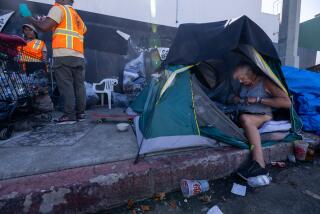Housing Crisis Is Seen Among Poor With HIV
- Share via
Low-income people with HIV or AIDS experience high rates of homelessness, and more public money is needed to develop long-term housing for independent living, according to a study released Wednesday by the city of Los Angeles and Shelter Partnership.
The study, believed to be the first in the nation to examine the housing needs of low-income people with HIV or AIDS in a metropolitan area, comes at a time when breakthroughs in medicine have been allowing people with HIV or AIDS to live longer and healthier lives.
“In the last four or five years, the phenomenon of AIDS has changed dramatically,” said Ferd Eggan, AIDS coordinator for the city of Los Angeles, whose office is one of the sponsors of the study. “We’re now starting to see a growing number of people who are HIV-positive but asymptomatic. They’re not exhibiting any signs of illness. They don’t require hospice care.”
Not surprisingly, one key finding was the priority placed by a majority of respondents upon long-term independent living rather than assisted-care facilities.
The study surveyed 785 people in the Los Angeles area and found that almost two-thirds had been homeless an average of 2.3 times in the last three years. More than half of those who had been homeless were homeless for periods ranging from two months to a year. The study broadly defined “homelessness” to include not only people living on the streets or in a car, abandoned building or homeless shelter, but also those who once lived on their own but had to “double up” with family or friends.
The survey’s methods were purposely not “scientific,” said Glenda Low, projects director for Shelter Partnership, the nonprofit organization that conducted the study. Rather than taking samples at random--which would allow the results to indicate broader trends in the overall population of people with HIV or AIDS--the study tried to target certain demographic groups.
“We purposely wanted more women and people of color for the survey,” Low said. “That’s who in the next 10 years will be having AIDS. The number of white men with AIDS is decreasing. Everyone else is increasing.”
About 20% of those surveyed were women, although women constitute only 9% of those with AIDS in Los Angeles. But the proportion of women is rising. In 1997, the most recent year for which complete statistics are available, women represented 13% of the new AIDS cases diagnosed, according to the Los Angeles County Office of AIDS Programs and Policy. Though whites accounted for 43% of AIDS cases overall, they were only 32% of the new cases in 1997.
The study’s respondents tended to be very poor. Three out of four said their monthly income was less than $700. Almost 40% spent more than half their monthly income on housing. They also experienced a high incidence of health problems not related to HIV or AIDS; 43% suffered from mental illness, and 28% suffered from alcoholism.
Other than people with HIV or AIDS, the study also surveyed 61 housing providers and 34 social services or health care programs. More than three-fourths of them anticipated changes in the housing needs of people with HIV or AIDS because of medical advances such as protease inhibitors.
The study’s results will “inform our decision-making on planning and allocation of [federal] dollars,” said John Maceri, chairman of the committee that advises the Los Angeles City Council, which administers countywide funding from Housing Opportunities for Persons With AIDS, a federal program that has allocated $8.8 million to the county in 1999.






